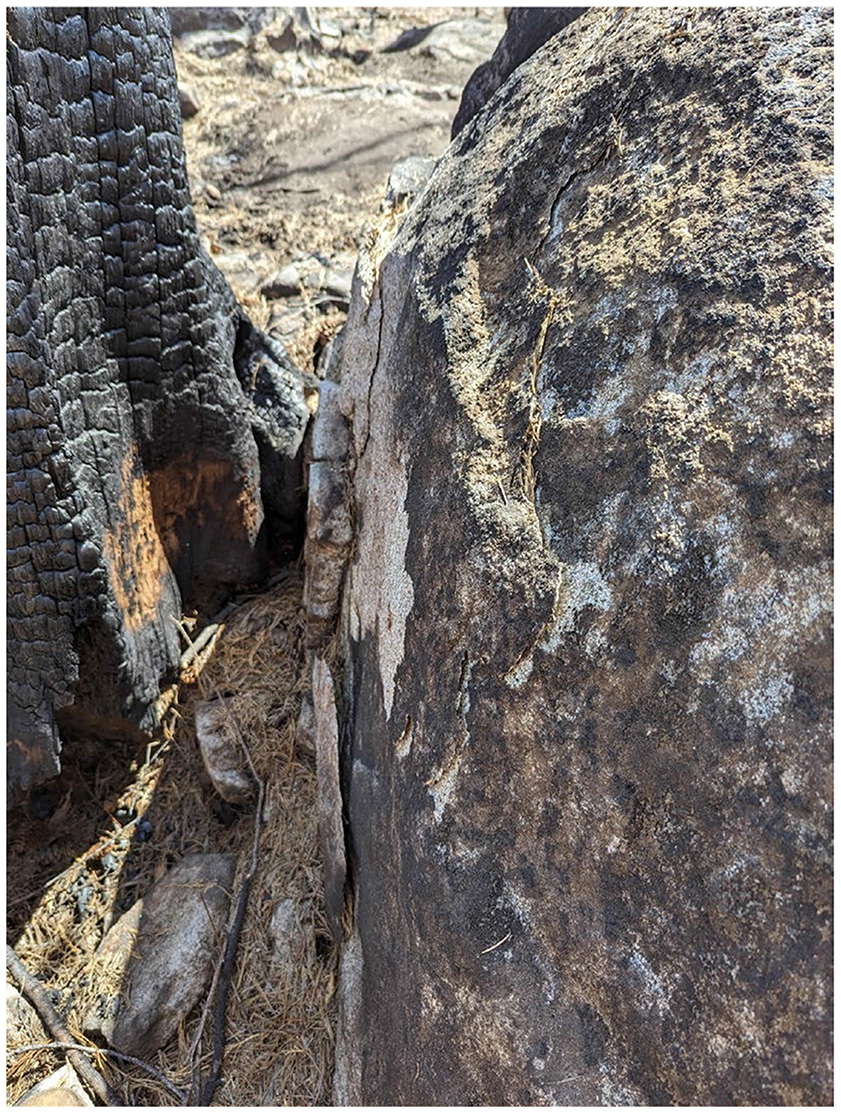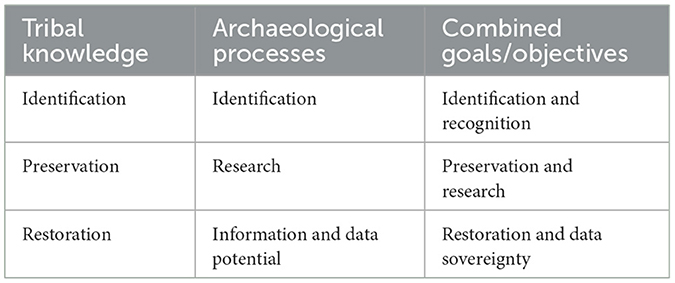- 1Department of Anthropology, University of California, Berkeley, Berkeley, CA, United States
- 2Nisenan/Washoe Knowledge Bearer, Auburn, CA, United States
- 3Indigenous Futures Society, Auburn, CA, United States
Catastrophic fire behavior in the Sierra Nevada range is increasing in tandem with worsening forest conditions related to non-Native approaches to fire ecology and climate change. Among the myriad negative human and community effects linked to thistrend, lesser understood are the relationships between differing forest management strategies and impacts to Ancestral Places or 'Esak 'Tima (Maidu and Nisenan for “places to learn”) which are living locations and traces of Ancestral practices that are integral to the health of Native Californian communities. Tribal Historic Preservation Offices, TEK specialists, and Tribal Leadership are on the front lines of government-to-government negotiations of sovereignty, especially with respect to their communities' living relationships with Ancestral Places. These are sometimes located in places managed by other institutions, agencies, and land occupiers and are most often far more than just dots on a map, but rather complex interconnected landscapes of Ancestral practices. These Tribal perspectives on guarding Ancestral Places are linked to not only the uses of Cultural Fire, or wénném sa in ecosystem restoration but also increasing aspects of the legibility and reincorporation of elements of Ancestral Places and Practices into healthy contemporary relationships with Tribal community members. These aspects of applied Traditional Ecological Knowledge and practice are highlighted in the relationships between wénném sa, Tribal archaeology, and forest management techniques our coalition is researching in California and are part of how our partnership in community-accountable archaeological research supports restorative justice. We foreground the principles of guardianship in the forest to build datasets that will support community priorities for Tribal access, food and medicine sovereignty, and intergenerational knowledge transfer. These kinds of direct action guardianship and mandated research will serve as models for co-management policies in other forests. Central to our efforts is demonstrating a model of evidence-based practice in recognition that leaders in our rapidly changing ecological reality cannot have a complete toolkit without them, especially if societies attempt to reconcile issues of racial just ice and sovereignty. Our partnership in this way connects heritage resource management to forest management and human rights policy while building community accountable research deliverables.
homa•ya be mi maidu
How are you people
homa •ya be mi ḱaw
How are you land/place/time
hěde oḱo hedem ḱaw ya-paǐ-to něs
This day this land/place/time we talk
nisě-k bě-těy honsěyi• nise•
Our story wake-up we
Huswěj ḱaw
Bless land
Huswěj maidu
Bless people
—Traditional Nisenan Prayer from April P. Moore
Brought together by fire
Tribal Historic Preservation Departments, Traditional Knowledge Bearers, and Elders are on the front lines of government-to-government negotiations of sovereignty in relation to and while maintaining connections to Native communities' active relationships with Ancestral Places. In the Sierra Nevada foothills region of California, Tribally owned lands are few and small in size, a consequence of Spanish Colonial interventions since the 1700′s, Gold Rush-era environmental destruction of the mid-1800s, broken US treaties of the nineteenth century, and state-sponsored genocide during the same eras. Ancestral places now are often lands managed by other institutions, agencies, and other non-native landowners, such as national, state, and city parks and forests, land-grab universities (Joseph A. Myers Center for Research on Native American Issues Native American Student Development, 2021), and private landholders. From a Tribal and anthropological perspective, these places are far more than just archaeological site dots on a map (Jochim, 2023), but rather complex interconnected landscapes of Ancestral practices (Ball et al., 2015). Complicating critical work, consultations with and planning by non-Native land managers with the Tribal community can omit or ignore (Vierra and Aguilar, 2022) critical aspects of traditional guardianship elements.
Worsening these issues, the authors have seen firsthand the result of wildfire on lands throughout California that have not been culturally tended for hundreds of years because of Spanish, Mexican, and then U.S. and California government policies of fire avoidance. We have observed up close the results of the recent King, Mosquito, and Caldor fires in this region of the Sierra Nevada, which caused massive ecological destruction, the literal blowing up (Figure 1) of places designated as archaeological sites and Traditional places, and catastrophic erosive events. While a dangerous and pervasive lack of forest health is well documented across North America (Burke et al., 2021) and disastrously evidenced by the mega wildfires that have done incalculable and potentially irreversible damage to biotic communities across the American West, little is known about how damage is concatenated with archaeological legibility of Ancestral Places. Among the myriad negative human and community effects linked (D'Evelyn et al., 2022) to this trend, lesser understood are the relationships between differing forest management strategies and impacts to Ancestral places. Mechanisms like climate change (Williams et al., 2019) and disastrous fire suppression policies of the twentieth century not only increase the danger of forest fire but also the damage to Ancestral places and the material evidence of Ancestral practices (Ryan et al., 2012).
Restoration of relationships with these sacred lands is a challenge that brought us together, Nisenan, Maidu, and Miwok Tribal members, Elders, Knowledge Bearers, academics, and managers, to envision the building blocks and accountability scaffolding necessary to co-craft working relationships. In one location where we are experimenting with these ideas, we meet and work together at the University of California Blodgett Research Forest. Our goals are to apply Traditional Ecological Knowledge and practices with actions steeped in the relationships between Cultural Fire, Tribal archaeology, and forest management techniques. Our Inter-Tribal and Inter-western group is researching and working to create a program that supports truly community-accountable archaeological research and Tribal-based Knowledge that supports restorative justice (Laluk et al., 2022), continued access, and re-establishes Tribal Guardianship and Tribal Data Sovereignty.
Deep forest-floor fuel loads that build in the absence of consistent good fire (Roos et al., 2020) obscure the traces of Ancestral Places and practices and make revisiting and using Traditional guardianship practices difficult if not impossible in locations where non-Native fire regimes, along with Traditional cultural practice suppression, have created these conditions. In our experience, even an Ancestral Place known to the community can be almost impossible to see, much less visit and maintain proper relationships with under the deep debris resulting from “flag and avoid” (Gillio, 2005, p. 20) types archaeological practices common in forest management. In this regime, “archaeological sites” recorded by non-Native surveyors are omitted from prescribed fire or other fuel reduction programs.
The result over the years is an ever increasing amount of combustible material and overgrown forest on top of the Ancestral Place. When these fuel loads do reach ignition, the damage to multiple levels of biotic communities may be difficult to recover from North et al. (2021) and certainly impact guardianship practices and continuing access for Tribal communities. The heat and intensity of these fires can actually damage Ancestral places through large-scale spalling of stone features and places (Figure 1), along with the destruction of soil, native plant and other biological elements that maintain Forest health (Sion et al., 2023), as well as the erosion and silting of landscape areas. In one case, a village location was slowly slipping off its ridge top location due to the sloughing of the critically burned and unsupported topsoils.
Additional forms of damage become apparent when community-mandated research using the types of non-invasive and low-impact archaeological instrumentation increasingly preferred by many Tribal communities is reduced in efficacy. Among the many ways access is reduced to the Ancestral Places, the instrument based surveys that preclude more invasive forms of archaeology are rendered less usable. As discussed in more detail below, this occurs because of massive thermal damage, the inability for proper coupling of the instrument with the ground surface, the inability of soils and ash to retain moisture properly, and the effective re-magnetization of soils and rocks by the heat of the fire.
Building the project
Tribal perspectives on guarding Ancestral Places are linked to the uses of Cultural Fire in ecosystem restoration (Long et al., 2020) but increasing aspects of the legibility and reincorporation of elements of Ancestral Places and Practices into healthy contemporary relationships with Tribal community members are critical. April Moore's Nisenan Prayer recognizes the inherent and circular links of land-place-time-people-health. Our challenge is to integrate these circular relationships with western-created linear hypothesis-based policies that insist on single-episode process and consultation rather than conversations and creating episodes of collaboration. Together, the authors have worked to nurture and restore breath to 'esak 'tima (Nisenan for “places to learn”) which are living locations and traces of Ancestral practices that are integral to the health of Native Californian communities and ecologies (Figure 2).
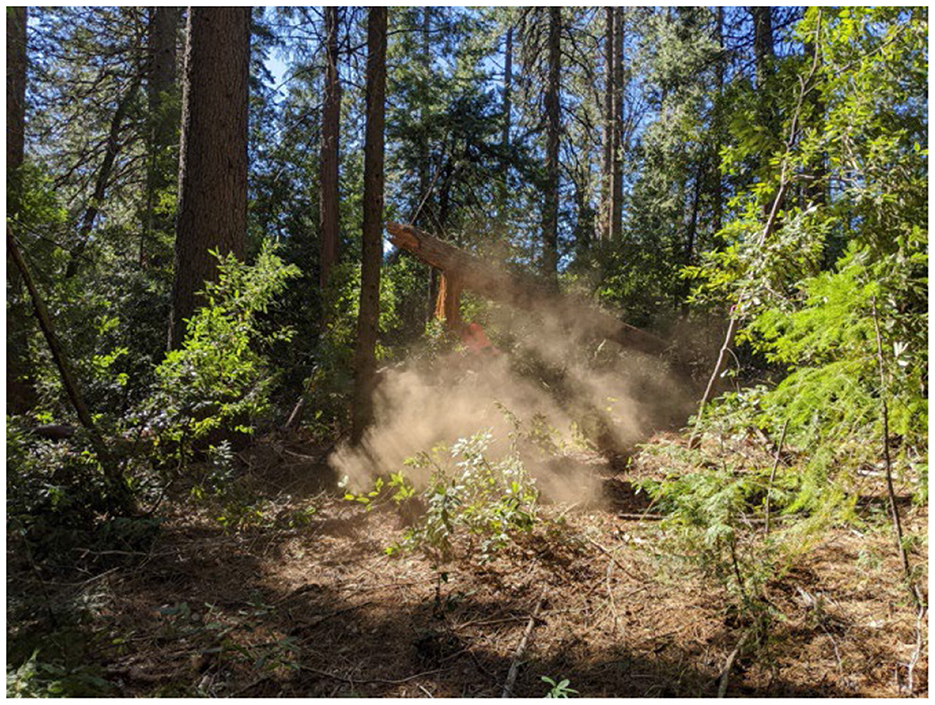
Figure 2. Putting guardianship principles into practice in an overburdened forest to help an ‘esak ‘tima breathe, Matt Moore demonstrates to the Flicker Crew a combination of chainsaw and TEK survey skills to uncover and protect near surface features attesting to Ancestral practices.
Beginning with an invitation from Nisenan, Maidu, Washoe, and Miwok Knowledge Bearers and Elders to work shoulder-to-shoulder with them—beginning with non-invasive technologies on Ancestral Places to restore proper relationships to the community—our coalition is co-crafting a collaborative research agenda for a multi-year project. United Auburn Indian Community began the invitation to invest in trainings and projects that mixed UC Berkeley faculty and students into their Intertribal Ecological Restoration and cultural fire crew, with the Colfax-Todds Valley Consolidated Tribe ultimately taking the reins on what would become the FLICKER (Fire Leadership for Intertribal Conservation Knowledge keeping Ecocultural Revitalization) Crew. Representatives from the Traditional Ecological Knowledge (TEK) Department of the Shingle Spring Band of Miwok Indians added their perspectives and cultural knowledge. This coalition in turn is collaborating with the managers and staff at the UC Blodgett Research Forest, Eldorado and Tahoe National Forests, we are learning and working to integrate the TEK of cultural fire with community-acceptable archaeological research (following Lightfoot, 2006), and tracking changes in forest management practices to amplify the interconnectedness of Ancestral practices and their signatures in heritage places with plentiful Indigenous biotic communities (e.g., Stillman et al., 2023).
Nisenan, Maidu, and Miwok Ancestors cared for the land that became the UC Blodgett Research Forest until Euroamerican homesteaders arrived in 1849 and began to log and pasture livestock. In 1850, California's new government passed the Act for the Government and Protection of Indians. That law banned the use of fire by Tribes and individual Tribal members. By 1933, the Michigan-California Lumber Company deeded lands that became the UC Blodgett Research Forest in order to provide a research site for practical demonstrations of forestry for students and industry partners. Although obscured by logging activities and the building overburden of combustibles some Ancestral Places (and practices) remain intact or can be restored to healthy relationships with descendant communities. Looking to restore relationships to a full range of 'esak 'tima, our coalition is using Blodgett as a model to build new forms of co-management and use of non-invasive archaeological technologies as complementary to more traditional guardianship principles and practices.
Combining goals for community-accountable research activities and outcomes
At the Blodgett research forest, we meet, listen, and build pathways to study and act on community priorities that mesh with our new understandings of the mechanics of landscape stability, fuel reduction, prescribed burning, cultural burning, connectivity to the past, and heritage. From a Tribal perspective, Restoration is bringing back something that lost, or remains but is obscured—access, knowledge, knowing. We strive to restore the circular movement of restoration, starting and ending with Traditional Place Knowledge. More than 20 years ago, Striplen and DeWeerdt (2002) highlighted successful integration of TEK with western science in management policy in Alaska, Oregon, and Mexico and advocated for this integration in the San Francisco Bay area and other California regions. These authors also noted the outcomes of restoring Traditional culture, knowledge, and foods. Their article foretold the importance of “creative interdisciplinary coalitions” that the authors embrace and add the directives of Guardianship and TEK circular integration with process and agency.
Traditional Knowledge Bearers and archaeologists sometimes use the same phrases yet with different meanings. Consideration of differing points of view can lead to better understanding and relevance of a cultural area (Table 1, adapted from Moore et al., 2022). As an example, from a non-Native archaeological perspective, fire causes disturbance and thus a perceived lack of site integrity. From a Tribal perspective, good fire causes the restoration of a sense of place and the living elements of a site. The Nisenan term for this is wénném sa (Figure 3).
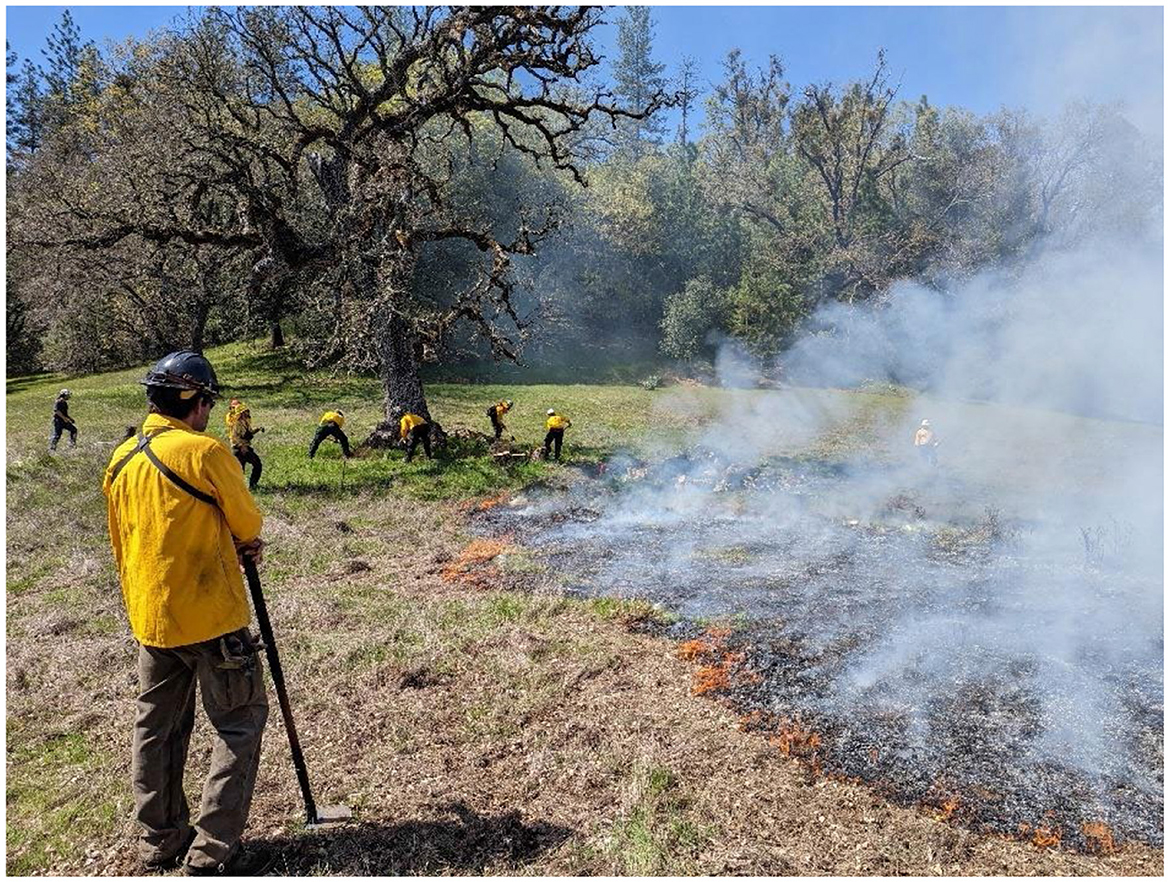
Figure 3. Matt More directing intertribal hand crew practicing wénném sa in the guardianship of a grandmother tree, adding smoke appropriately and cleaning, but keeping other Ancestral Practices evident in stone and other mediums safe from the heat.
Tribal identification and understanding of cultural values always consider the local environment. From a Tribal perspective, ecological resources are cultural resources, particularly when those resources are an integral part of the Tribal landscape. Traditional Ecological Knowledge is an evolving form of knowledge acquired by Indigenous peoples over hundreds or thousands of years of actively managing and being in contact with the environment. This knowledge is expressed through oral and written knowledge, practices, beliefs, and active stewardship. Archaeological identification tends to focus on mapping and documentation of features that constitute non-Native conceptions of a site and are typically described with boundaries that define areas of perceived human activity. These are not oppositional points of view, yet neither must they be conflated, as doing so can lead to the undermining of Tribal knowledge.
Tribes typically privilege preservation of Ancestral places. Those places hold knowledge relevant to the past and the present. Archaeological studies typically focus on the potential of archaeological sites to contain information and data. Again, these are not opposing views. Tribal considerations of Ancestral places often include oral history, as well as published maps, histories, ethnographies, and other references, as well as information from the Ancestral place itself. Events and time periods associated with Ancestors are important to Tribal identity. The value of information as a mechanism for intergenerational knowledge sharing is central to the importance of Ancestral places. Sharing knowledge about a place and its history is part of a place's restoration. When Ancestral places are recognized, they breathe (Figure 2).
Restoration serves as a method for bringing balance within the cultural, encompassing ecological aspects and spiritual consideration. Tribal guardianship represents robust and culturally distinct practices that evolve to uphold a Tribe's fundamental values regarding the interconnectedness of cultural sites, communities, and their surrounding landscapes, even in the face of significant obstacles to these relationships. Tribal guardianship has historically exemplified the cultural fortitude and resilience of Tribal communities, while also providing a foundational framework for the ongoing sovereignty and Indigenization of cultural sites and landscapes.
With continued conversations, collaboration, and access, Tribal Knowledge and archaeological processes can be integrated into combined goals (Table 1) that inform policy and respond to the needs of particular Ancestral places. Creative coalitions have the opportunity to serve the needs of both communities.
Building an archaeological program with guardianship and 'esak'tima
Our coalition has foregrounded the principles of guardianship and 'esak 'tima in Blodgett Forest to build datasets that will support community priorities for Tribal access, food and medicine sovereignty, intergenerational knowledge transfer, and ecological and community health. These kinds of direct-action guardianship and mandated research may serve as models for co-management policies in other forests (Washburn, 2022). The work supports Tribal struggles for self-determination through multi-generational, mentored intensive forest and heritage management practices, as heritage locations are tended by cultural practitioners and relationships are rebuilt with a view toward long-term dynamics that protect these places of learning.
Central to our efforts, planning for and monitoring the effects of reintroduction of cultural fire techniques is a critical focus of practicing TEK and integrating TEK with more western approaches (when appropriate). Building upon recent calls to create research agendas that link archaeology, fire science, and fire management strategies (Snitker et al., 2022), we are demonstrating a model of evidence-based practice in recognition that leaders in our rapidly changing ecological reality cannot have a complete toolkit without them, especially if societies attempt to reconcile issues of racial justice and sovereignty (Artelle et al., 2019). Important social and environmental justice issues must account for not only impacts of climate change on contemporary Indigenous communities (Sogbanmu et al., 2023) but also on the Ancestral Places being damaged (Welch et al., 2023), grounding the Native communities in their culture and history. Our partnership in this way connects heritage resource accountabilities to forest management policy. Our goals are to build community-accountable research deliverables that inform forest management policy and practices yet maintain Indigenous data sovereignty.
Implementing low-impact archaeological ways of knowing
Our coalition uses ground penetrating radar, magnetometry, electrical soil resistivity, LiDAR, and RTK-enabled multispectral drone imagery to conduct non-invasive research into the archaeological legibility and preservation of 'esak 'tima in locations exposed to different types of fire regimes. These include locations in Blodgett Forest and by invitation to work on private lands that belong to Nisenan, Maidu, Miwok, and Mono individuals and communities. Our work documents the range of thermodynamic modifications from out-of-control wildfire (e.g., Caldor and King Fires), prescribed “industrial” burns (e.g., Mosquito Fire control sectors), and wénném sa as they affect the long-term safety of Ancestral Places.
In these locations (embargoed from publication to protect them), our program emphasizes the ability of contemporary Tribal communities and members to access, use, and integrate guardianship into community priorities for intergenerational knowledge transfer. We host overnight camps for Tribal schoolchildren, teachers, and Knowledge Bearers. Other allied Native Californian communities assist with these efforts and offer opportunities, host demonstrations, and lead Inter-Tribal workshops which our coalition has sponsored and presents in conjunction with their own Cultural Fire practices and on their Ancestral Places (Goode et al., 2022).
Through these experiences, we recognize that we need a higher resolution suite of georeferenced aerial imagery, and for the imagery to be captured in multiple spectra to quantify and document the pre- and post- wénném sa application status of indigenous biotic communities, erosional profiling, and watersheds. This is especially important to do in concert with the ongoing use of wénném sa combined with phenological timing and ontogenetic development cycles of plants to favor the destruction of invasive species and the encouragement of fire-adapted native species along multiple trophic levels (Palomino and Kelly, 2019). But how to disarticulate these dynamics from the increasing fire severity that is changing our biome (Thomsen and Ooi, 2022)?
Use of real time kinematic (RTK) drone systems (accuracy ~5 cm) and ground base stations, along with multispectral imagery and recurrent and replicable sorties to document change through time are complementary to our ground based geophysical suites of instruments but give far larger, landscape scale evidence to support cultural burning strategies (Figure 4). Our use of drone technologies and post-processing software monitors phenological events, grounded in Indigenous taxa and use that targets the precision use of wénném sa on the land to restore health to the earth, and in turn the people. Several years (of which we are on the second cycle) of repeated application to Ancestral Places, captured before and after application of wénném sa are necessary for the coalition to adjust decisions for guardianship across the range of locations.
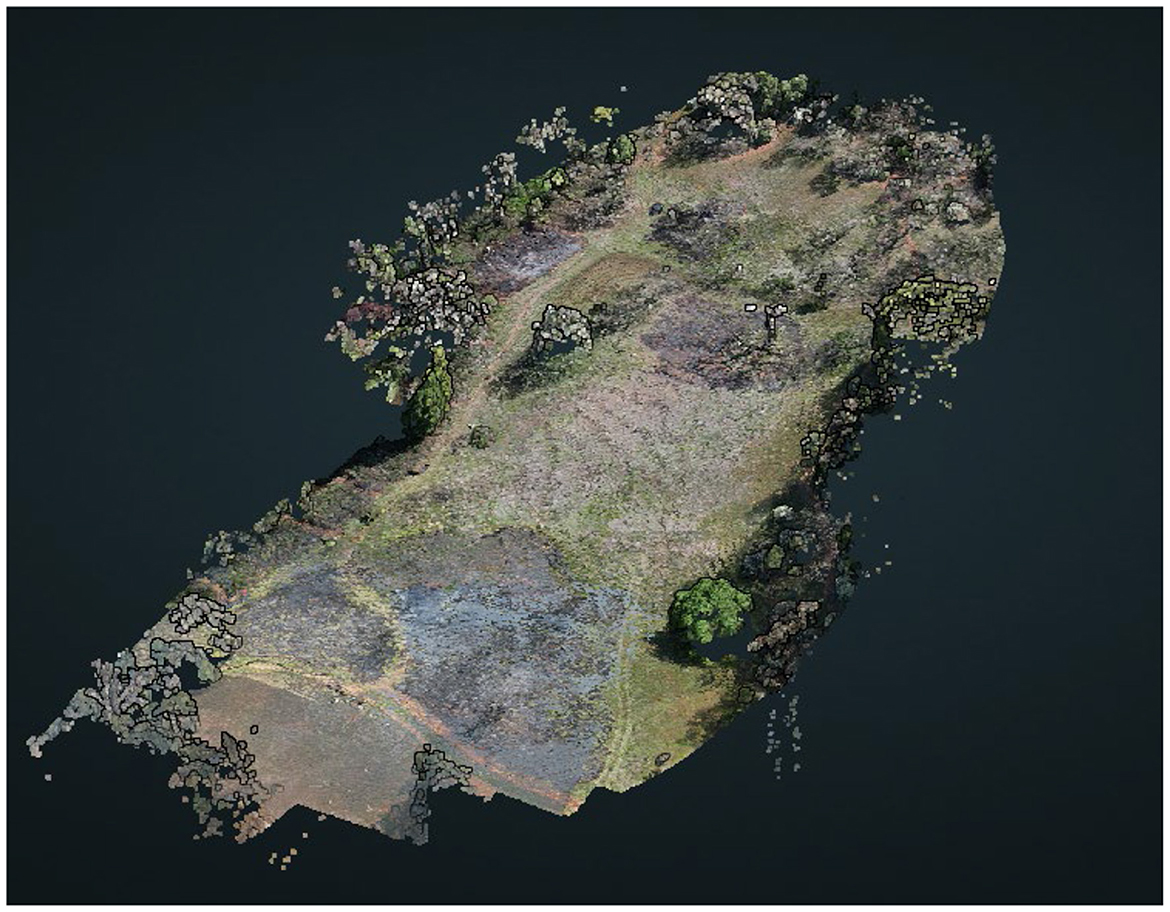
Figure 4. RTK multispectral drone model of wénném sa on an Ancestral place through time, showing regenerative techniques applied to encourage the growth and health of fire-adapted native plants and their relations in the place of invasive species.
Ground penetrating radar is another example of how an instrument can be adapted to address the challenge. During field data collection, a ground penetrating radar unit must have close contact between the antenna body and the ground surface to avoid signal attenuation and to get maximum resolution from detected subsurface density differentials and aid in interpreting the emergent interography of the Ancestral place (Sunseri and Byram, 2017). In a forest mismanaged with fire suppression, there is an almost immediate disincentive for the use of ground penetrating radar because of the lack of ability to execute full transects of antenna coupling with the ground surface because of so much non-photosynthesizing vegetation distributed across the ground surface, reducing the ability for connection (Figure 2). Some of our most helpful interpretive tools for sharing and considering how to re-engage community with an Ancestral place–2D plan view maps of subsurface phenomena—are all but impossible in these scenarios because multiple, parallel, closely spaced, and regular transects cannot be achieved; individual cross-sectional transects cannot be stitched together with fidelity in software to create different slice maps at different depths (Figure 5).

Figure 5. Slice maps of emergent subsurface phenomena created by closely-spaced parallel transects (25 cm) made possible by careful surface clearing and tending and the use of ground penetrating radar antennae of much higher resolution than the standards used by most practitioners.
In a forest where prescribed or industrial fire is used, the amount of heat produced creates an ash layer that reduces the efficacy of the radar because it is so much lighter and creates a signal attenuation for the incommensurate ground density beneath that shallow layer. At the same time, that same ash layer associated with prescribed and industrial fire hampers the growth of many native plant species. Excess heat can obscure the kinds of clearly delineated density gradients that repeated compaction of the soil surface through human activity might reveal as a house floor.
In a space where wénném sa guardianship practices are implemented, the reduction of woody non-photosynthesizing vegetation and the phenological timing of fire adaptive native Californian plants allows for closer coupling of the radar antenna (Figure 6) with the ground and the resultant ash layer is so thin that a boot heel scratch reveals healthy biotic soil less than a half inch under the burn surface. This means a more consistent coupling, fewer density changes in the first few inches of radar signal return, and a landscape healthy with cycles of native plant growth.
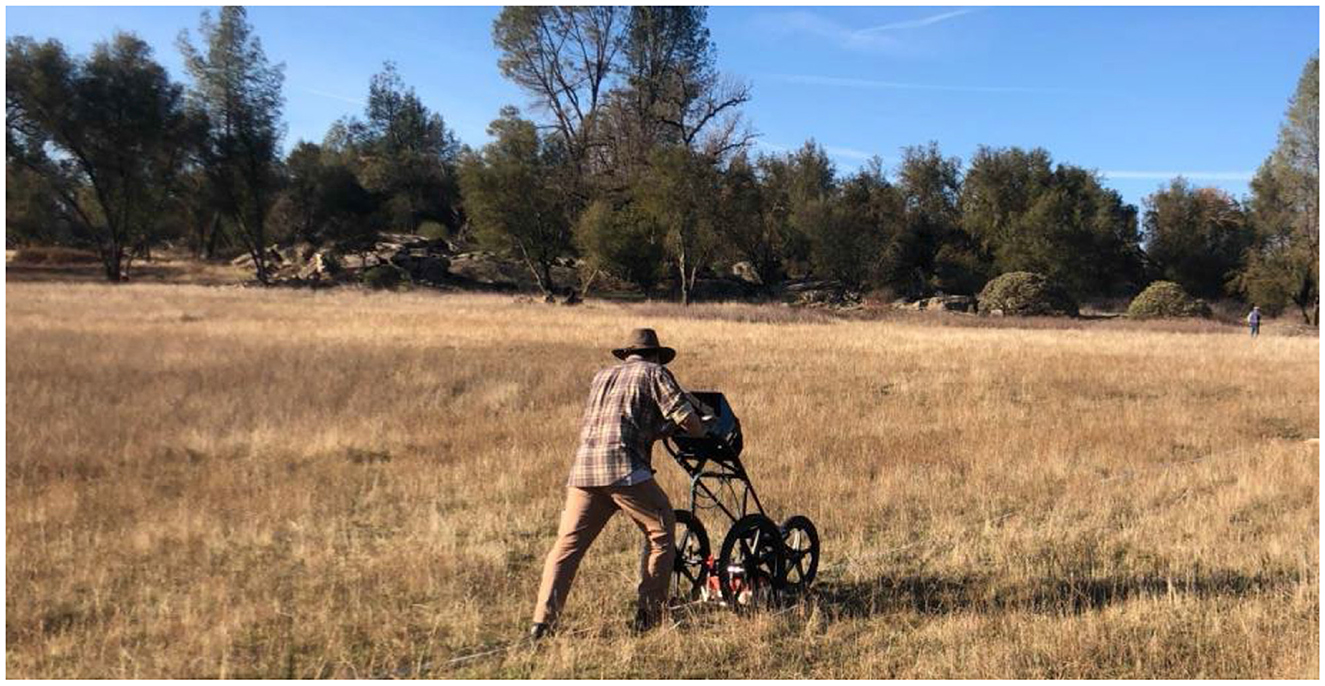
Figure 6. Ground penetrating radar use benefitting from close ground-coupling conditions and precise grid layouts made possible by wénném sa guardianship practices (photo courtesy of Susan Brazer).
Use of magnetic gradiometer is not recommended in areas where wildfire and prescribed fire heat can be so intense that granite boulders and grinding complexes spall and can be destroyed by the intense heat (Figure 1). Intense heat effectively resets the magnetic signature of stone elements in the landscape and may obscure or completely erase the kinds of features and Ancestral practices that might be visible with the use of magnetometers, such as harvest, earth ovens, and other Ancestral thermal processing facilities (Figure 7). Electrical soil resistivity tomography similarly suffers in the aftermath of wildfire and prescribed fire use on landscapes. If substantive ash layers reduce the connectivity and required residual moisture levels for electrical soil resistivity probes, then survey transects and data legibility will be profoundly affected.

Figure 7. Ancestral thermal practices made visible to magnetic gradiometry and protected by Tribal guardianship practices (image courtesy of Louis Curson Mayorga).
In contrast, use of guardianship practices allow an Ancestral place to breathe and create conditions that produce relatively easy landscapes to see sets of features and Ancestral places and uses, particularly in conjunction with ground penetrating radar. Cultural low-intensity fires produce much less heat saturation of the ground surface and hence less magnetic distortion to confound magnetic radiometer studies and native plants striving for the surface.
Challenges and opportunities ahead
The Resource Legacy Fund and the University of Washington recently sponsored the 2024 online publication of a manifesto that called for braiding Indigenous and western knowledge to create healthy climate-adapted forests within the United States (Eisenberg et al., 2024). This publication, important for its multi-vocality, emphasizes place-based stewardship, reciprocity, and ecocultural restoration. It also shows the way for community-based archaeology programs to have meaning and usefulness for Indigenous communities. Tribal communities in the Sierra Nevada region are slowly gaining access to Ancestral places that have been cut off to them for centuries. Exploration and understanding of these places gives opportunity for creative coalitions to rediscover and bring every tool we have at our disposal in service of what has always been there.
Using drones and geophysical instrumentation is in and of itself an endeavor that demands expertise in an extensive suite of safety and code regulations, flight skills, mission planning, hardware, sensors, data processing and analytics. Efforts dedicated to these issues can collect the leading researchers in this field to focus on the intersections of archaeological site legibility, preservation, and changing forest fire eco- and cultural dynamics. Our coalition's work is a timely response to the need to develop not only the technical aspects of the research tools, but also to protect the intellectual property of our Native Californian partners (Martinez et al., 2023) with respect to sensitive data. With our research products thus far, sharing only within the coalition is central to the mandate we received from Tribal Leadership. Respecting this, multiple observation and partnered work opportunities via presentations, field trips, and overnight teaching and learning events onsite are designed into the ongoing collaborative timeline for Knowledge Bearers, Tribal members, and Councils to assess the alignment of the work with community priorities and principles of respect, reinvestment, and accountability.
In following the lead of Tribal Mentors who are restoring guardianship practices to Ancestral places, our coalition of Tribal practitioners, academic archaeologists, land managers, and Tribal leadership aim to bring together the best of our methodologies in the service of better outcomes for all. As government agencies and Tribal Historic Preservation Departments around the country integrate more and more use of cultural fire into their programmatic approaches to Guardianship (Lake, 2021), the potential for academic archaeologists to serve as allies increases. With mandates directly from Tribal Leadership, the use of non-invasive and low impact technologies such as mapping, ground penetrating radar, magnetic, radiometry, electrical soil, resistivity, tomography, LiDAR, and multi-spectral drone imaging has become critical to many communities.
Yet rather than solely relying upon these technologies and other more invasive archaeological techniques to search for and document Ancestral places and practices, their use in conjunction with long-proven Traditional Guardianship techniques increases the potential for intergenerational knowledge transfer for all (Figures 3, 8). Indigenous seven-generation planning strategies offer organic opportunities and closer articulations with land managers who actually seek Tribal co-management and Tribal guardianship as a goal, such as at UC Blodgett. This “two-eyed” seeing (Bartlett et al., 2012), integrating Tribal knowledge with western science and management, centers anthropological-based ethics into archaeological practice.
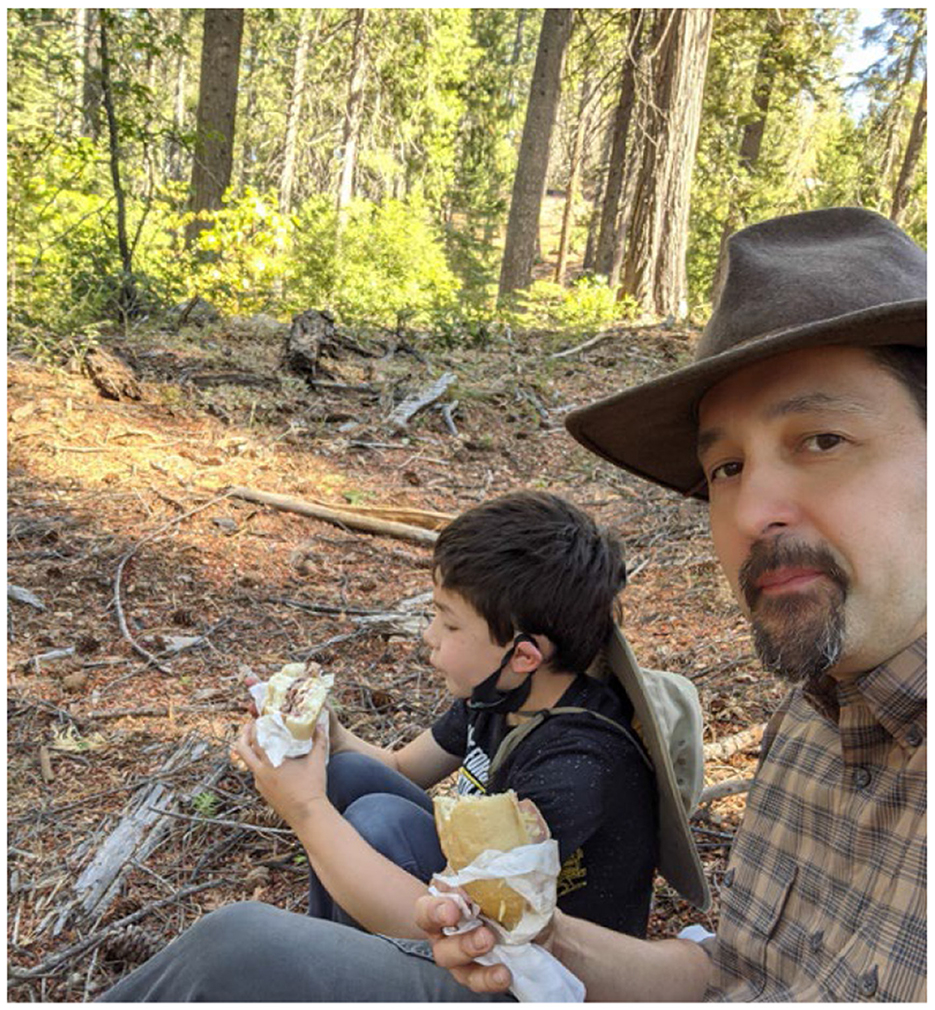
Figure 8. Father and son take a break during a teachable moment reviewing wildfire damage to an Ancestral place while learning new ways to approach and apply guardianship principles and practices with respect. Figure contains images of the author(s) only.
The goal of our partnership is to retool the set of geophysical instrument and remote sensing methodologies to continue partnered work with the Native Californian Tribal Leadership on the use of wénném sa as guardianship of Ancestral places, restoration of traditional ecological management, and maintenance of food sovereignty. The toolkit itself serves as a means to generate the kinds of understandings that will lead to ever-closely aligned co-management and ultimate rematriation of landscapes to original guardian communities. Critical to the success of implementing these new tools is an intensive process of learning how to use different kinds of instruments, including Ground penetrating radar, magnetometry, soil resistivity, LiDAR, and RTK connected drones for multi-spectral imagery, photogrammetry, and volumetric comparisons through time, in ways that coincide with the goals of Tribal partners. In turn, these are only some of the means our coalition uses to quantify the strides we are making in protecting sacred places while also increasing carbon sequestration in the forests that we are using as study locations. We also leave time and space for 'esak 'tima, the learning that an Ancestral place brings, and the ability to gather, and let the land/place/time speak with us.
Data availability statement
The datasets presented in this article are not readily available because Tribal authorization only. Requests to access the datasets should be directed to bWF0dGhld21vb3JlMzY4QGdtYWlsLmNvbQ==.
Author contributions
JS: Conceptualization, Data curation, Formal analysis, Funding acquisition, Investigation, Methodology, Project administration, Resources, Software, Supervision, Validation, Visualization, Writing – original draft, Writing – review & editing. MM: Conceptualization, Investigation, Methodology, Project administration, Resources, Supervision, Writing – original draft, Writing – review & editing. RA: Conceptualization, Funding acquisition, Investigation, Methodology, Project administration, Resources, Supervision, Writing – original draft, Writing – review & editing.
Funding
The author(s) declare that financial support was received for the research and/or publication of this article. Some travel funds for Jun Sunseri provided by the Stahl grant of the Archaeological Research Facility of UC Berkeley.
Acknowledgments
We are deeply indebted and grateful for the knowledge sharing of Malissa Tayaba, Krystal Moreno, Pamela Cubbler, Ron Goode, Bill Lenard, Brian Wallace, and Anne Wallace. At UC Blodgett, we truly appreciate allies like Ariel Roughton, Kestrel Grevatt, Rob York, and Scott Stephens. Where would we be without the inspiration of our mentors and Tribal youth leaders Sadie Hampshire, Marcus Hampshire, Brandon Prout, Justin Prout, and their colleagues from the FLICKER Crew? Colleagues like Zack Emerson, Nico Tripcevich, Scott Byram, Susan Brazer, and Cherilyn Ashmead lent their talents and patience to the work, as did the extraordinary crew of students, Shelby Medina, Twyla Piatote, Louis Curson-Mayorga, Emily Langton, and their colleagues from the UC Berkeley Bear Bones Lab for Community-Accountable Archaeology.
Conflict of interest
The authors declare that the research was conducted in the absence of any commercial or financial relationships that could be construed as a potential conflict of interest.
Generative AI statement
The author(s) declare that no Gen AI was used in the creation of this manuscript.
Publisher's note
All claims expressed in this article are solely those of the authors and do not necessarily represent those of their affiliated organizations, or those of the publisher, the editors and the reviewers. Any product that may be evaluated in this article, or claim that may be made by its manufacturer, is not guaranteed or endorsed by the publisher.
References
Artelle, K. A., Zurba, M., Bhattacharyya, J., Chan, D. E., Brown, K., Housty, J., and Moola, F. (2019). Supporting resurgent Indigenous-led governance: a nascent mechanism for just and effective conservation. Biol. Conserv. 240:108284. doi: 10.1016/j.biocon.2019.108284
Ball, D., Clayburn, R., Cordero, R., Edwards, B., Grussing, V., Ledford, J., et al. (2015). A Guidance Document for Characterizing Tribal Cultural Landscapes. Camarillo, CA: US Department of the Interior, Bureau of Ocean Energy Management, Pacific OCS Region, 548.
Bartlett, C., Marshall, M., and Marshall, A. (2012). Two-eyed seeing and other lessons learned within a co-learning journey of bringing together Indigenous and mainstream knowledges and ways of knowing. J. Environ. Stud. Sci. 2, 331–340. doi: 10.1007/s13412-012-0086-8
Burke, M., Driscoll, A., Heft-Neal, S., Xue, J., Burney, J., and Wara, M. (2021). The changing risk and burden of wildfire in the United States. Proc. Natl. Acad. Sci. 118:e2011048118. doi: 10.1073/pnas.2011048118
D'Evelyn, S. M., Jung, J., Alvarado, E., Baumgartner, J., Caligiuri, P., Hagmann, R. K., et al. (2022). Wildfire, smoke exposure, human health, and environmental justice need to be integrated into forest restoration and management. Curr. Environ. Health Rep. 9, 366–385. doi: 10.1007/s40572-022-00355-7
Eisenberg, C., Prichard, S. J., Nelson, M. P., and Hessburg, P. (2024). Braiding Indigenous and Western Knowledge for Climate-Adapted Forests: An Ecocultural State of Science Report. University of Washington Fire Landscapes Adaptive Management and Ecology Lab, Seattle, WA.
Gillio, D. A. (2005). Flagging the Trail: One Hundred Years of Managing Cultural Resources. USDA Forest Service, Southwestern Region, Albuquerque, NM, Report No. 17.
Goode, R. W., Beard, S. F., and Oraftik, C. (2022). Putting fire on the land: the Indigenous people spoke the language of ecology, and understood the connectedness and relationship between land, water, and fire. J. Calif. Great Basin Anthropol. 42, 1.
Jochim, M. A. (2023). Dots on the map: issues in the archaeological analysis of site locations. J. Archaeol. Method Theory 30, 876–894. doi: 10.1007/s10816-022-09580-8
Joseph A. Myers Center for Research on Native American Issues and Native American Student Development (2021). The University of California Land Grab: A Legacy of Profit from Indigenous Land—A Report of Key Learnings and Recommendations. Berkeley, CA: University of California.
Lake, F. K. (2021). Indigenous fire stewardship: federal/tribal partnerships for wildland fire research and management. Fire Manag. Today. 79: 30–39.
Laluk, N. C., Montgomery, L. M., Tsosie, R., McCleave, C., Miron, R., and Carroll, S. R. (2022). Archaeology and social justice in Native America. Am. Antiq. 87, 659–682. doi: 10.1017/aaq.2022.59
Long, J. W., Lake, F. K., Goode, R. W., and & Burnette, B. M. (2020). How traditional Tribal perspectives influence ecosystem restoration. Ecopsychology 12, 71–82. doi: 10.1089/eco.2019.0055
Martinez, D. J., Seraphin, B., Marks-Block, T., Nelson, P., and Vinyeta, K. (2023). Indigenous fire futures: anticolonial approaches to shifting fire relations in California. Environ. Soc. 14, 142–161. doi: 10.3167/ares.2023.140109
Moore, M., Allen, R., and Starkey, A. (2022). “Best practices for section 106, Tribal identification, preservation, and restoration,” in Presented During THPO Talk, National Association of Tribal Historic Preservation Officers. Auburn, CA: United Auburn Indian Community.
North, M. P., York, R. A., Collins, B. M., Hurteau, M. D., Jones, G. M., Knapp, E. E., et al. (2021). Pyrosilviculture needed for landscape resilience of dry western United States forests. J. Forest. 119, 520–544. doi: 10.1093/jofore/fvab026
Palomino, J., and Kelly, M. (2019). Differing sensitivities to fire disturbance result in large differences among remotely sensed products of vegetation disturbance. Ecosystems. 22, 1767–1786. doi: 10.1007/s10021-019-00367-9
Roos, C. I., Rittenour, T. M., Swetnam, T. W., Loehman, R. A., Hollenback, K. L., Liebmann, M. J., et al. (2020). Fire suppression impacts on fuels and fire intensity in the western US: Insights from archaeological luminescence dating in northern New Mexico. Fire 3, 32. doi: 10.3390/fire3030032
Ryan, K. C., Jones, A. T., Koerner, C. L., and Lee, K. M. (2012). Wildland Fire in Ecosystems: Effects of Fire on Cultural Resources and Archaeology, RMRS-GTR-42-vol. 3. Fort Collins, CO: U.S. Department of Agriculture, Forest Service, Rocky Mountain Research Station.
Sion, B., Samburova, V., Berli, M., Baish, C., Bustarde, J., and Houseman, S. (2023). Assessment of the effects of the 2021 Caldor megafire on soil physical properties, eastern Sierra Nevada, USA. Fire 6:66. doi: 10.3390/fire6020066
Snitker, G., Roos, C. I., Sullivan, A. P. III., Maezumi, S. Y., Bird, D. W., Coughlan, M. R., et al. (2022). A collaborative agenda for archaeology and fire science. Nat. Ecol. Evol. 6, 835–839. doi: 10.1038/s41559-022-01759-2
Sogbanmu, T. O, Gordon, H. S. J., El Youssfi, L., Obare, F. D., Duncan, S., Hicks, M., et al. (2023). Indigenous youth must be at the forefront of climate diplomacy. Nature 620, 273–276. doi: 10.1038/d41586-023-02480-1
Stillman, A. N., Wilkerson, R. L., Kaschube, D. R., Siegel, R. B., Sawyer, S. C., and Tingley, M. W. (2023). Incorporating pyrodiversity into wildlife habitat assessments for rapid post-fire management: a woodpecker case study. Ecol. Appl. (2023) 33:e2853. doi: 10.1002/eap.2853
Striplen, C., and DeWeerdt, S. (2002). Old science new science: incorporating traditional ecological knowledge into contemporary management. Conserv. Pract. 3:3. doi: 10.1111/j.1526-4629.2002.tb00036.x
Sunseri, J. U., and Byram, S. (2017). Site interiography and geophysical scanning: Interpreting the texture and form of archaeological deposits with ground-penetrating radar. J. Archaeol. Method Theory 24, 1400–1424. doi: 10.1007/s10816-017-9324-4
Thomsen, A. M., and Ooi, M. K. J. (2022). Shifting season of fire and its interaction with fire severity: impacts on reproductive effort in resprouting plants. Ecol. Evol. 12:e8717. doi: 10.1002/ece3.8717
Vierra, B. J., and Aguilar, J. R. (2022). Communication, understanding, and sacred landscapes. Papers Archaeol. Soc. New Mex. 48, 239–243.
Washburn, K. K. (2022). Facilitating Tribal co-management of federal public lands. Wis. L. Rev. 263:2790. doi: 10.2139/ssrn.4052790
Welch, J. R., Cowell, S., Ryan, S. L., Whiting, D., and Cantley, G. J. (2023). Cultural resource damage assessment. Adv. Archaeol. Pract. 11, 111–125. doi: 10.1017/aap.2022.46
Keywords: archaeology, Traditional Ecological Knowledge, cultural fire, non-invasive archaeology, community accountable archaeology
Citation: Sunseri J, Moore M and Allen R (2025) Hěde oḱo hedem ḱaw ya-paǐ-to něs: this day this land/place/time we talk. Front. Environ. Archaeol. 4:1547180. doi: 10.3389/fearc.2025.1547180
Received: 17 December 2024; Accepted: 02 June 2025;
Published: 25 June 2025.
Edited by:
Gabriel Sanchez, University of Oregon, United StatesReviewed by:
Mark Nesbitt, Royal Botanic Gardens, United KingdomSadie Weber, University of São Paulo, Brazil
Copyright © 2025 Sunseri, Moore and Allen. This is an open-access article distributed under the terms of the Creative Commons Attribution License (CC BY). The use, distribution or reproduction in other forums is permitted, provided the original author(s) and the copyright owner(s) are credited and that the original publication in this journal is cited, in accordance with accepted academic practice. No use, distribution or reproduction is permitted which does not comply with these terms.
*Correspondence: Jun Sunseri, anN1bnNlcmlAYmVya2VsZXkuZWR1
 Jun Sunseri
Jun Sunseri Matthew Moore2
Matthew Moore2 Rebecca Allen
Rebecca Allen